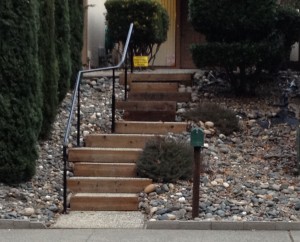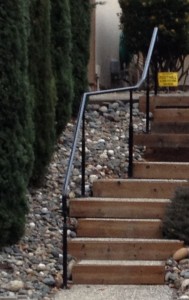Get a Grip On Avoiding Dangerous Staircase Accidents
Most people appreciate the danger of wet, icy, or uneven stairs, but many homeowners don’t realize that hand rails–or the lack thereof–can be a major factor in avoiding liability for stair-related accidents.
PROPERLY INSTALLED HAND RAILS HELP AVOID ACCIDENTS–AND LIABILITY.
Most houses have staircases, either inside or outside the home. Almost all full-length staircases (meaning those allowing access from the ground floor to floors above or below) are constructed with hand rails (and often, guard rails) to offer people a hand hold while climbing. However, many shorter staircases, particularly in outdoor areas, are constructed without railings or grips.
Any staircase creates a risk of slip and fall injuries, as well as other personal injury and even death. A slip from any height can cause serious or fatal injury, especially when head trauma is involved. Without a railing to hold while ascending and descending, or to grab in the event of missteps, a person walking up and down stairs is at a far greater risk of accidental injury.
The lack of a handrail or grip is a factor courts and juries consider when determining if a homeowner has liability for accidents occurring on his or her property. Where hand rails are mandated by law, the lack of a properly-installed railing can constitute negligence in itself. Even where hand rails are optional, however, a homeowner may be held liable if a reasonable person would have recognized–and mitigated–the risk by installing proper railings.
COMPLIANCE WITH BUILDING CODES AND RAILING ORDINANCES IS MANDATORY
Many building codes, including those in Los Angeles County, not only require hand rails on full-sized staircases, but also require intermediate railings on staircases more than 44″ wide. (California Code of Regulations, Title 8, Section 3214.) There are some exceptions to this rule, but homeowners need to check all applicable laws–and make sure their contractors do so–before installing or remodeling staircases at a home or business.
California law also regulates the height of railings. Handrails installed after April 3, 1997 must be between 34″ and 38″ above the nosing of stair treads and landings. (Hand rails installed on stairs before that date can be anywhere from 30″ to 38″ in height.) (CCR, Title 8, Section 3214.)
Regulations also govern the minimum distance between a handrail and the wall (1.5″) and the minimum weight load the hand rail must be able to bear without breaking (200 pounds of force, applied in any direction and at any point on the rail). (Id.)
Local laws and building codes may vary, so be aware: the rules above may or may not apply in your situation. Check your local building codes carefully before building or remodeling stairs.
SAFETY FIRST — INSTALL RAILS ON HAZARDOUS STAIRS
If you own a home with stairs, remember: even one step is enough to cause a dangerous or deadly fall. Examine your stairs from all angles, at all times of day, and in different kinds of weather. Do they get slippery in the cold or rain? Does the height of the stairs create a falling hazard? Better safe than sorry. Install appropriate hand rails on hazardous or slippery stairs to help prevent accidents.
A sturdy grip may prevent far more than just a twisted ankle.
© 2014 Ross Law
















